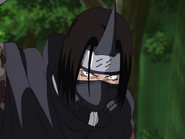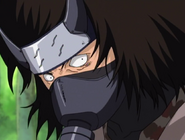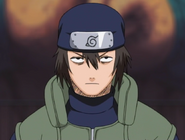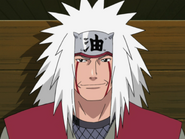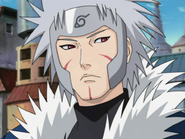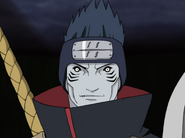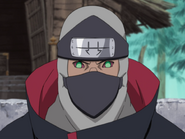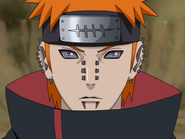A forehead protector (額当て, Hitai-ate) is a headband composed of an iron[1] metal plate and a band of cloth. Forehead protectors are worn by most shinobi and are engraved with the symbol of their hidden village. Forehead protectors have been worn since at least the time of Asura Ōtsutsuki, though there was no engraving then.[2]
Meaning[]
Forehead protectors are usually worn as a sign of pride and fealty for one's village. Ninja consider it an honourable, important part of their tradition, and make a point of wearing it at all times, especially when sparring with a comrade from the same village. Although not wearing a forehead protector is frequently viewed as disrespectful to one's village and peers,[3] a ninja who does not wear one may still be loyal to their village. Similarly, to have one's protector removed is to denote one's unworthiness to the name "ninja", as Naruto did to Boruto for cheating during the Chūnin Exams.[4] When a ninja is to be stripped of their position from the Shinobi Organisational System due to a transgression of protocols, they are to relinquish their protectors as well, as Boruto, Sarada and Mitsuki were to give up their forehead protectors for their unauthorised entrance to Iwagakure (despite Naruto personally praising them for their noble actions).[5]
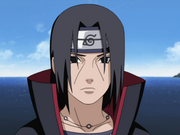
A scratched forehead protector.
Some missing-nin, such as Zabuza Momochi, continue wearing their forehead protector even after they've left their village. Akatsuki members who retain their forehead protectors carve a long, horizontal scratch across the symbol, to show they have rescinded their allegiances and rejected their villages. Villagers of Amegakure aligned with Pain bear the same scratches across their forehead protectors, but remain loyal to the village; it symbolises their victory during the civil war against Hanzō.
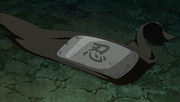
The Allied Shinobi Forces' forehead protector.
In preparation for the Fourth Shinobi World War, Mifune designs a new forehead protector to be worn by members of the Allied Shinobi Forces. Engraved with the kanji for shinobi (忍), it symbolises that, whereas once each ninja fought for their villages separately, they now stand united under one banner for the same cause. The members of the Alliance wear this in place of their original forehead protector.
Variations[]
Placement[]
Despite being called a "forehead protector", it is not necessary for a ninja to wear it on their forehead or even on their head at all.
- Sakura Haruno wears hers as a hair-band.
- Genma Shiranui wears his like a bandanna with the village symbol facing backward.
- Hayate Gekkō, Ebisu and Ibiki Morino wear theirs like bandannas with the village symbols facing forward.
- Kankurō wears his on his hood.
- Kakashi Hatake wears his as a makeshift eye-patch.
- Hinata Hyūga and Temari (Part I only) wear theirs around their necks.
- Shikamaru Nara wears his on his upper left arm.
- Chōjūrō uses his like a badge on his chest.
- Yagura Karatachi uses an undershirt in which his protector is in the middle.
- Fū wears hers on her right arm.
- Gaara wraps his around the strap that covers him.
- Might Guy, Rock Lee and Metal Lee wear theirs as a belt.
- Ino Yamanaka ties hers around her midsection in Part I.
- Konan's is not ordinarily visible; she wears hers underneath her cloak on her right hip.
- Sasuke Uchiha keeps his forehead protector on him at his waist as a symbol of his friendship with Naruto.
- Iwabee Yuino wears his by attaching it to his belt like a keychain.
- Enko Onikuma wears her forehead protector's metal plate hanging around her neck like a necklace.
Colour[]
- Navy Blue: The most common colour of forehead protectors. Many ninja keep this colour for the entirety of their ninja career.
- Black: The second most common colour of forehead protectors. Some, such as Naruto Uzumaki, even switch from blue to black after the timeskip.
- Crimson: Common among ninja of Iwagakure. Also used by Hebiichigo, Ichirōta Oniyuzu, Hassaku Onomichi, Buntan Kurosuki, Rock Lee and Might Guy and, after the timeskip, Sakura Haruno and Chōji Akimichi.
- White: Though rarely seen, several Kumogakure ninja use it, as do the Four Celestial Symbols Men.
- Purple: Has been used by those loyal to Otogakure and Hoshigakure. Inoichi Yamanaka and the Gold and Silver Brothers also use purple.
- Brown: Seen briefly in the ninth OVA, worn by a Kumogakure genin.
- Dark Green: Has been used by genin of Kusagakure in the anime: Team Kazami.
- Light Green: Has been used by Wasabi Izuno of Konohagakure
- Orange: Has been used by Namida Suzumeno and Tsuru Itoi of Konohagakure
Design[]
There have been some cases where the design of the metal plate or cloth has been modified in some way, beyond mere cloth colour.
Trivia[]
- On the cover for chapter 567, each jinchūriki is shown with a white forehead protector with the kanji for the number of tails of their respective tailed beasts.
- Masashi Kishimoto, in an interview, noted that he created forehead protectors because he found it too cumbersome to draw Naruto's goggles every week.
- In episode 27 of Naruto SD: Rock Lee no Seishun Full-Power Ninden, Chōza is seen wearing a forehead protector with the kanji "shinobi", similar to the ones worn by the shinobi of the Allied Shinobi Forces.
- Upon imagining his life if he had returned to Konoha after Rin Nohara's death, Obito depicted himself wearing a modified forehead protector with covers that stretched down his left eye to conceal his empty eye socket.[6]
- Most forehead protectors are depicted as being tied in a knot behind the person's head, although notably Amegakure shinobi wear protectors with no knot required, implying they are elasticated protectors. Several older shinobi are either seen using custom protectors, or older styles. This style used by Amegakure appears to have been universally implemented after the Fourth Shinobi World War, as all Konohagakure genin — such as Boruto Uzumaki — are shown using them.
- The Wandering Ninja Clan have no village symbol on their forehead protectors, similar to Asura Ōtsutsuki's.
- The practical portion of the Genin Exams in Konohagakure, after the curriculum's amendment, involves the students being given a white bandanna that serves as their "life". If the students graduate from the exam, the proctor will remove the Transformation Technique over the bandannas, revealing them to be forehead protectors.[7]
- Missing-nin who seek refuge in Curtain Village tend to sell their forehead protectors to support their poverty-stricken lives, indicating they have monetary value.[8]
References[]
- ↑ Rin no Sho, page 264
- ↑ Naruto chapter 462
- ↑ Naruto chapter 175
- ↑ Boruto: Naruto the Movie
- ↑ Boruto episode 92
- ↑ Naruto chapter 651
- ↑ Boruto episode 37
- ↑ Boruto episode 160

